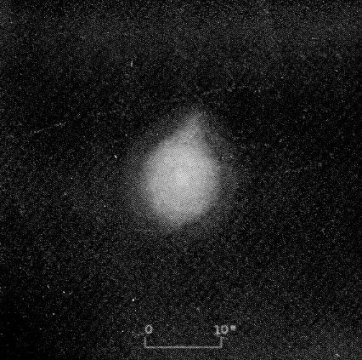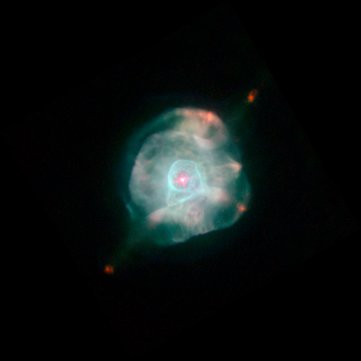IC 4593
"Central star...surrounded by a disk of bright matter...fading out
a little toward the edges...bright wing at north...and a smaller
and fainter projection opposite this." So says Curtis in
describing his composite drawing of IC 4593 on the left. From the
Hubble image on the right, he very much GOT it right. The bulge at
the northern (top) end is clearly seen on the Hubble image, and is
related to a bipolar jet of the sort that makes the prominent ansae
in NGC 7009, the red color coming from
low-excitation ionized nitrogen. In IC 4593, however, there is
evidence for an additional shocked flow to the lower right. Within
this very low excitation, and surely youthful,
planetary nebula is
an interior shell that is probably the result of the interaction
between the nebula and a fast (1600 kilometer per second) hot wind
from the central star; similar structures are seen in NGC 6543 and IC 418.
IC 4593 lies in far southern Hercules five degrees southeast of Gamma Serpentis (in the western section of
Serpens, Serpens Caput). Distance
determinations range from 3000 to 10,000 light years. The only
individual actual measures are at the lower end, the best estimate
3400 light years, the shorter distance consistent with a smaller
diameter of 0.2 light years (from an angular
diameter of 13 seconds of arc) and youth. The 11th magnitude (11.3)
central star is still heating with a current relatively low
temperature of 35,000 Kelvin (measures range from 28,000 K to
42,000 K), far too low to doubly ionize the helium. The luminosity
lies in the low thousands. Youth is also implied by a typically-
low expansion velocity of 12 kilometers per second. Helium and
nitrogen abundances are normal, if not low.
IC 4593 is distinctive in being surrounded by a giant halo similar
to that seen around NGC 6543. More than three times the size of
the inner nebula, at the adopted distance it gives the whole
structure a diameter of 0.7 light years.
Left: Image and quote by H. D. Curtis from Publications of the Lick
Observatory, Volume 13, Part III, 1918. Right: NASA, ESA, and the
Hubble Heritage Team (STScI/AURA).



